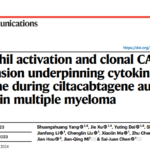In August 2023, Professor Jun Ma and his team from Harbin Institute of Hematology Oncology published a paper in the Journal of Leukemia & Lymphoma titled "Efficacy and safety of mitoxantrone hydrochloride liposome injection in treatment of peripheral T-cell lymphomas: a multicenter, non-interventional, ambispective cohort, real-world study (MOMENT)." The study evaluates the effectiveness and safety of liposomal mitoxantrone hydrochloride injection in the real-world treatment of peripheral T-cell lymphoma (PTCL).The treatment of peripheral T-cell lymphoma (PTCL) with liposomal mitoxantrone hydrochloride injection has demonstrated significant efficacy and good tolerability, making it a viable treatment strategy.
This study is a real-world research with a ambispective cohort (MOMENT study), including clinical data from 198 patients who received mitoxantrone hydrochloride liposome injection as monotherapy or combination therapy at 37 hospitals in China from January 2022 to January 2023, including 166 patients in the retrospective cohort and 32 patients in the prospective cohort; 10 patients in the treatment‐naïe group and 188 patients in the relapsed/refractory group.
The study shows that all 198 patients were treated with mitoxantrone hydrochloride liposome injection for a median of 3 cycles (range 1-7 cycles); 28 cases were treated with mitoxantrone hydrochloride liposome injection as monotherapy, and 170 cases were treated with the combination regimen. Among 188 relapsed/refractory patients, 45 cases (23.9%) were in complete remission (CR), 82 cases (43.6%) were in partial remission (PR), and 28 cases (14.9%) were in disease stabilization (SD), and 33 cases (17.6%) were in disease progression (PD), with an objective remission rate (ORR) of 67.6% (127/188). Among 10 treatment ‐ naïe patients, 4 cases (40.0%) were in CR, 5 cases (50.0%) were in PR, and 1 case (10.0%) was in PD, with an ORR of 90.0% (9/10). The median follow‐up time was 2.9 months (95% CI 2.4-3.7 months), and the median PFS and OS of patients in relapsed/refractory and treatment ‐ naïe groups were not reached. In relapsed/refractory patients, the difference in ORR between patients with different number of treatment lines of mitoxantrone hydrochloride liposome injection [ORR of the second‐line, the third‐line and ≥he forth‐line treatment was 74.4% (67/90), 73.9% (34/46) and 50.0% (26/52)] was statistically significant (P = 0.008). Of the 198 PTCL patients, 182 cases (91.9%) experienced at least 1 time of treatment‐related adverse events, and the incidence rate of ≥rade 3 adverse events was 66.7% (132/198), which was mainly characterized by hematologic adverse events. The ≥grade 3 hematologic adverse events mainly included decreased lymphocyte count, decreased neutrophil count, decreased white blood cell count, and anemia; non‐hematologic adverse events were mostly grade 1-2, mainly including pigmentation disorders and upper respiratory tract infection. Conclusions The use of mitoxantrone hydrochloride liposome injection‐containing regimen in the treatment of PTCL has definite efficacy and is well tolerated, and it is a new therapeutic option for PTCL patients.
After summarizing patient clinical characteristics, efficacy, and adverse events, this study found that the treatment of peripheral T-cell lymphoma (PTCL) with liposomal mitoxantrone hydrochloride injection has significant efficacy and good tolerability. It emerges as a new treatment option for PTCL patients based on the analysis of overall survival (OS) and progression-free survival (PFS) outcomes.


